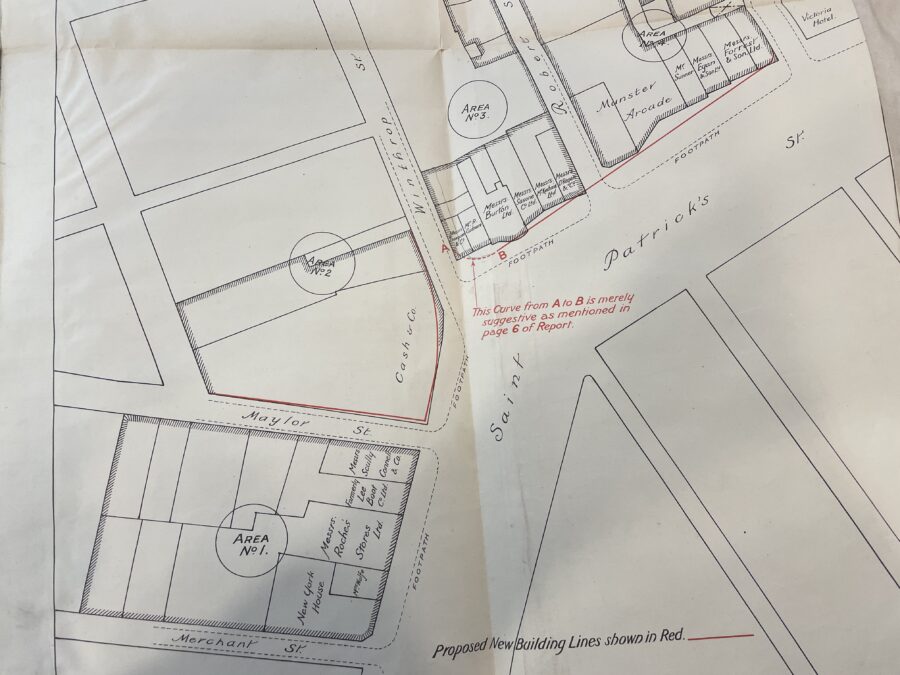
Kieran’s Our City, Our Town Article,
Cork Independent, 16 September 2021
Journeys to a Truce: The Rebuilding Pana Report
September 1921 coincided with several notes being published by the Reconstruction Committee of the Corporation of Cork outlining their six-month review in the Cork Examiner. By an order of the Council of the Corporation of Cork on 26 February 1921 a special committee consisting of one member from each electoral area was appointed to supervise the work of reconstruction of the destroyed portion of the city during the Burning of Cork event on 11/12 December 1920.
The committee was authorised to co-opt members from other bodies such as the Cork Industrial Development Association, the Technical Instruction Committee, the Employers Federation, the District Trades and Labour Council and the Cooperative Building Federation. The committee was seen as thoroughly representative of the industrial, commercial, and labour interests of the city.
Between February and September 1921, six meetings of the general committee were held and their minutes are recorded in a surviving minute book (1921-1924) in Cork City and County Archives. Many discussions also took place between a sub committee, which was appointed to deal with the nuanced details, and to formulate proposals with the owners, architects and builders of the relevant premises.
Cork Corporation building bye-laws dictated that premises could only be re-erected without the permission of the Reconstruction Committee, whose job was to approve plans for entire buildings, so that proposed schemes could be viewed and regulated. The same applied to the temporary timber premises that had been erected – of which twelve businesses are recorded as located on cleared plots within the St Patrick’s Street area by late September 1921. Time limits were placed on temporary structures in order that actual rebuilding work be incentivised.
Despite the building by-laws, it was a fine balance by the Reconstruction Committee to give business owners some leeway, ask that rebuilding work be started but also create a spirit of collaboration. Many owners were still emotionally raw, were broke, could not survive on the offers of insurance companies, and needed more time to think about their future needs.
The job of the committee was also to lobby for the compensation packages arising out of damage, inflicted by British forces, to be delivered. But by September 1921, there was still no compensation forthcoming from Westminster. In general, it was hoped that perhaps part of the Truce negotiations may bring a significant compensation fund and one that could especially kick start the owner of a property, who did not have reserve funding put aside in order to rebuild.
In his six month review, chair of the Reconstruction Committee Cllr Barry Egan details that aside from compensation funding, one of the prominent aspects regularly discussed at committee level was the possible re-alignment of building lines in the damaged St Patrick’s Street area plus creating a widened Winthrop Street. In the pre-Burning of Cork era, footpaths were narrow and some buildings, constructed in the nineteenth century jutted out in front of their adjacent ones.
Winthrop Street, which was a much narrower street to what exists today, was targeted for widening and for creating more of a plaza as it meets St Patrick’s Street. It was suggested that the work could be accomplished by acquiring the burnt out sites of Messrs Thompson, Murphy and Tyler, and to determine a new building line running north and south through their sites.
To allow for more space, it was also proposed to close up and build over the next street – west of Winthrop Street – that of Robert Street – and transfer back the whole of what was described as block number three across the width of the street – in otherwards eliminate the street. Discussions were held with property owners on Robert Street but strenuous opposition was put forward to the closing of that thoroughfare. The City Solicitor advised the Reconstruction Committee that streets could not be closed or eliminated except upon an agreement being entered into with the owners and occupiers of the property therein. The Robert Street closure was eventually put to one side in the negotiations.
Negotiations between the Reconstruction Committee and the business owners were intensive. However, the minute books do reveal positive public support for the work of the committee. In the six-month report, Cllr Egan places on record the committee’s high appreciation of the manner in which Mr William Roche of Roches Stores met the committee and the concessions supplied so far from him. The object with him was trying to rectify a building line in area number one on St Patrick’s Street and to possibly increase the width of Merchant Street on the western side. Messrs J Daly and company Ltd expressed a full sympathy with the improvements proposed by the committee and their willingness to make a concession of property towards the widening of Merchant Street. Merchant Street in time though was subsumed into Merchant’s Quay shopping in the 1990s.
There is an addendum document to the committee’s six-month report. Joseph Delany, the City Engineer, outlines his concerns that without plans being submitted, the rebuilding ran the risk of building heights and respective architectural design being out of sync with neighbouring rebuilds. Technically a business could come back with just a one storey design and with a jarring architectural design. The City Engineer references the need to set a fixed policy on the use of Irish materials such as local limestone in particular. Mr Delany noted: “if there is no standard as to height there are possibilities of one-storey deformities placed in juxtaposition to buildings of three or four storeys high on either side. Balance, symmetry, unity, harmony in design will be difficult to achieve under these conditions of procedure by individuals”.
Caption:
1117a. Section of map produced from Reconstruction Committee Minute Book, 1921-1924, showing proposed building plot re-alignments (see red line) (source: courtesy of Cork City and County Archives, ref: CP/CM/RE/1).